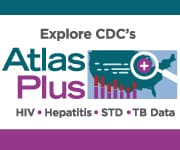Data Dissemination Resources
Data captured for decision making are disseminated through various platforms such as surveillance reports, Morbidity and Mortality Weekly Report (MMWR) articles, National HIV/AIDS Strategy (NHAS) Progress Reports, AtlasPlus, and dashboards.
-
AtlasPlus: National Center for HIV/AIDS, Viral Hepatitis, STD and TB Prevention (NCHHSTP) AtlasPlus is an interactive tool that gives users the ability to create customized tables, maps, and charts using more than 15 years of CDC’s surveillance data on HIV, viral hepatitis, STD, and TB. AtlasPlus provides quick access to updated national, state, and county-level data Indicators, such as social determinants of health, and allows users to view social and economic data in conjunction with surveillance data for each disease. This platform makes data transparent and accessible to everyone.
-
Surveillance Reports: HIV surveillance reports are disseminated on the current epidemiology of HIV and include special reports on topics such as social determinants of health, behavioral risk factors, and clinical outcomes.
- Morbidity and Mortality Weekly Report and Other Publications: The (MMWR is a weekly publication prepared by CDC. Often called “the voice of CDC,” the MMWR series is the agency’s primary vehicle for scientific publication of timely, reliable, authoritative, accurate, objective, and useful public health information and recommendations. CDC publishes approximately 200 scholarly articles each year in the MMWR, reporting on meaningful HIV research and implementation science activities that inform current and future HIV prevention activities. PRS Systematic Reviews and Publications
- National Progress Reports: National progress reports incorporate data from the different systems to reflect the hard work accomplished and the lessons learned across agencies since the first national HIV strategy was published in 2010. Moreover, they reflect the scientific advances that bring the United States closer to eliminating new HIV infections and the disparities that persist among some populations.
-
AHEAD Dashboard: America’s HIV Epidemic Analysis Dashboard (AHEAD)* is a data visualization tool that displays jurisdictional data on the Ending the HIV Epidemic (EHE) initiative’s six core indicators: Incidence, Knowledge of Status, Diagnoses, Linkage to HIV Medical Care, Viral Suppression, and PrEP Coverage. Tracking these six EHE indicators helps stakeholders, jurisdictions, and other partners use up-to-date data to make key decisions on programs and interventions to reach the goals of the EHE initiative. The data displayed in AHEAD come from the various surveillance systems.
*The AHEAD dashboard was developed by the HHS through its Office of Infectious Disease and HIV/AIDS Policy in collaboration with the CDC, HRSA, NIH, HUD, Indian Health Service, Substance Abuse and Mental Health Services and the Office of the Assistant Secretary for Health. - Infographics/Fact Sheets: CDC compiles data and creates products that summarize the information into easily understandable formats, including PowerPoints, infographics, and fact sheets on national indicators (e.g., incidence, diagnoses, linkage to care). CDC and our partners use these reports and fact sheets to assist with decision-making regarding resource allocation and to help communicate important public health messages to policy audiences and the public.
- Visit the HIV Resource Library website where these resources are readily accessible to stakeholders and the general public.
- Additional resources that highlight key issues and data for policy makers.


